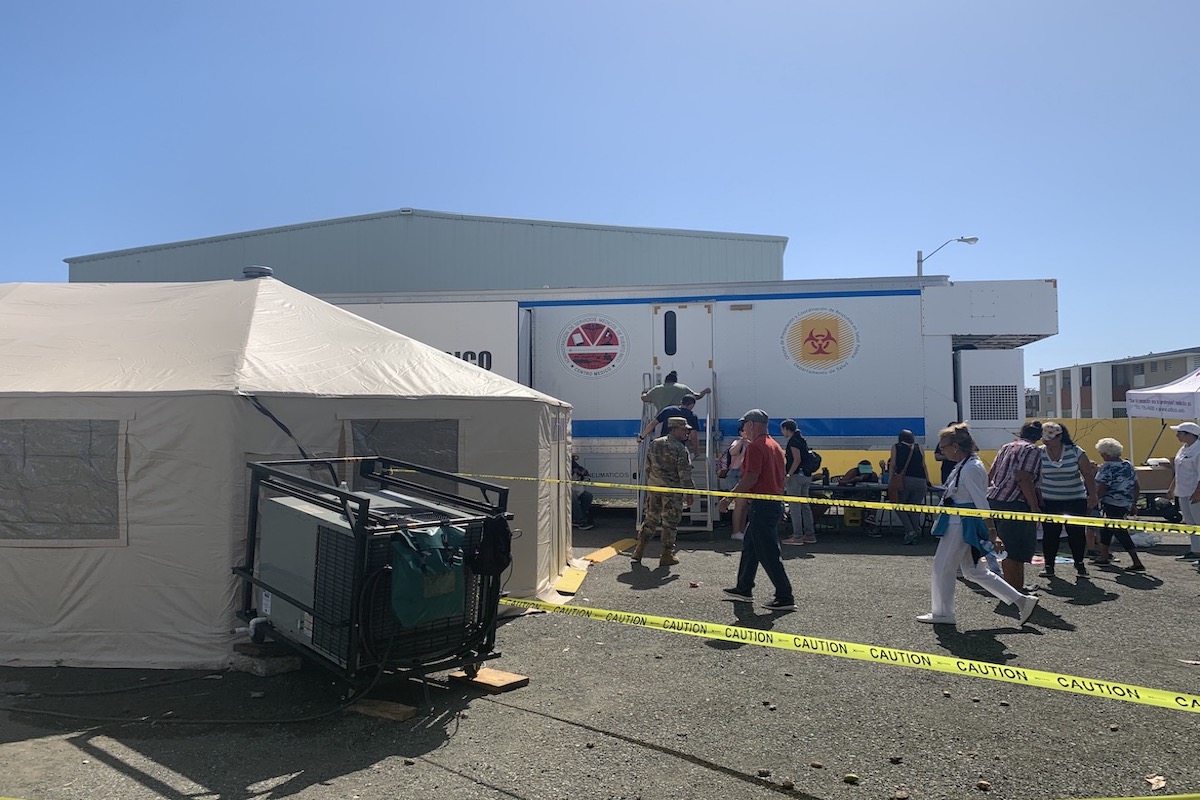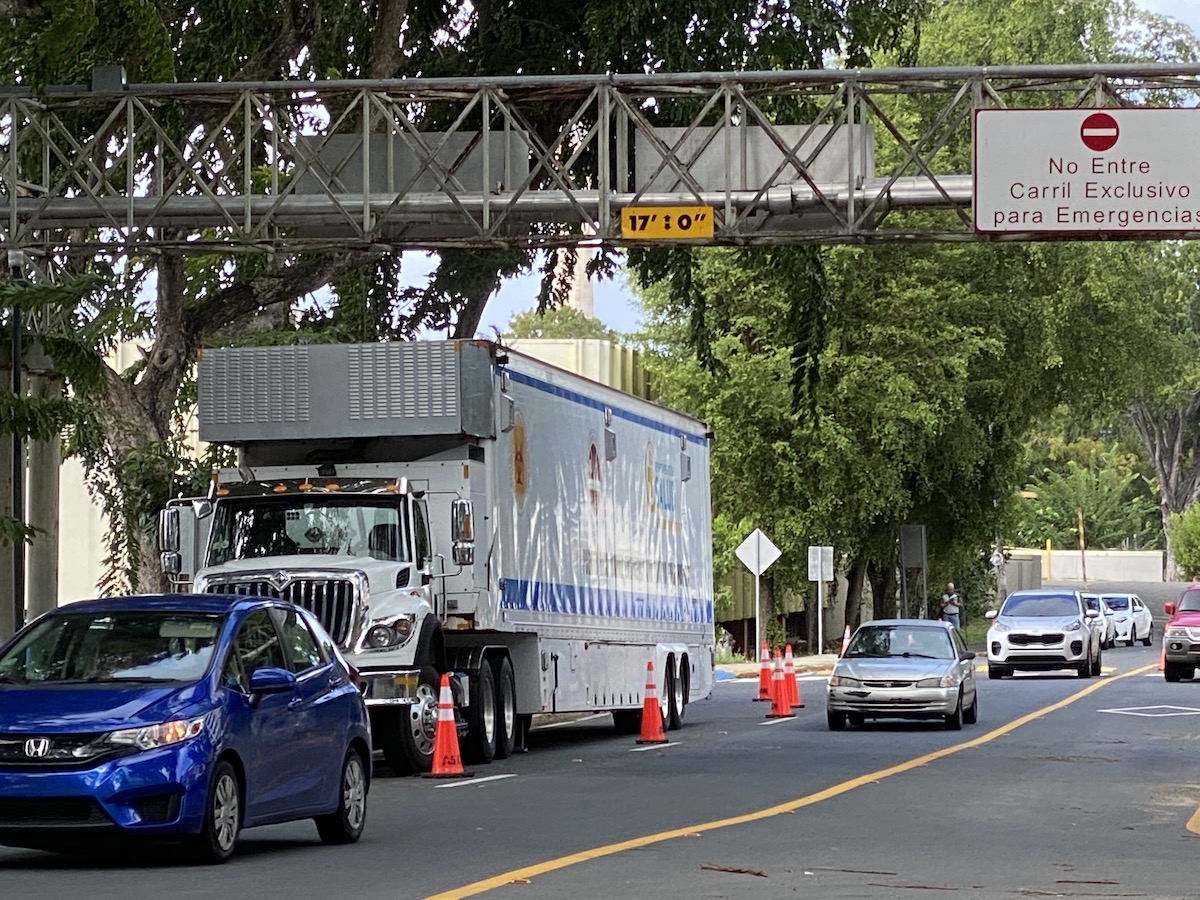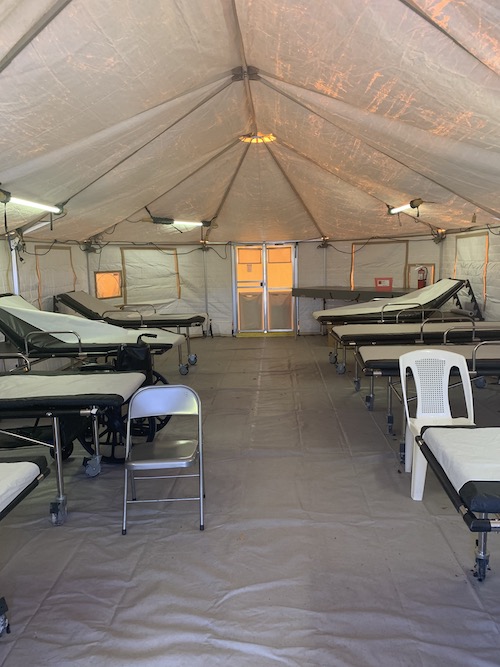

The Health Department established last week a mobile hospital in Guánica. (Photo by Jeniffer Wiscovitch | Centro de Periodismo Investigativo)
By Omaya Soya Pascual and Jeniffer Wiscovitch
Versión en español aquí.
SAN JUAN, Puerto Rico — The greatest immediate death threat after earthquakes, such as those Puerto Rico has experienced for more than two weeks, are traumas that people may be exposed to in the face of a structural collapse. But Health Secretary Rafael Rodríguez Mercado has not shared a plan to address this risk nor has contacted his specialized trauma team since the earthquakes began, dangerously exposing the public.
So far, the director of the only trauma center on the island, the Medical Center’s Trauma Hospital, and president of the Puerto Rico Trauma Committee before the American College of Surgeons, Dr. Pablo Rodríguez Ortiz, has not been contacted by Rodríguez Mercado neither before nor during the emergency that has already claimed two lives, has downed dozens of structures, resulting in more than 2,000 evacuees.
Rodríguez Mercado has not shared the current written plan —the Public Health and Medical Services Emergency Management Operational Plan— with his trauma director, nor has he addressed the hospital’s structural deficiencies, according to internal sources and documents obtained by the Center for Investigative Journalism (CPI, in Spanish). The 1,048-page plan only mentions the Trauma Hospital once and makes brief mentions about the Medical Center’s role in an emergency such as an earthquake.
Rodríguez Mercado, a neurosurgeon, is responsible for the Medical Center, the Trauma Hospital and the Medical Services Administration (ASEM, in Spanish) that runs these institutions.
The Health Secretary did not respond to the CPI’s request for an interview since Friday to answer questions on the matter, and to identify his plan to attend to trauma patients if there were an earthquake and stronger aftershocks than the over 1,000 experienced during the past 16 days.
Dr. Rodríguez Ortiz confirmed in an interview that Rodríguez Mercado has not reached out to him and said with obvious indignation, that he is worried about the catastrophe it may pose for Puerto Ricans, since his hospital is the only one prepared to attend to these patients. He doesn’t know what the procedure would be if there were a high volume of victims. He said, unfortunately, Rodríguez Mercado and the director of ASEM, Jorge Matta, are his superiors in the government and although he has the moral responsibility and expertise, he does not have the authority to make decisions on planning, execution and use of resources.
The trauma surgeon, who has been running the hospital for more than 20 years under two different governing parties, noted that trauma service is crucial during an earthquake because 80% of the victims die if they are not treated within the first hour of distress.
“Right now, I have no instructions on this, when it’s my responsibility to coordinate the trauma response during a catastrophe. I don’t even know what tools I can count on to plan and execute this response, nor do I know which resources I have available or what to do and what to stop doing,” Rodríguez Ortiz said.
He explained that although the orientation and prevention efforts that have been made so far to protect life are good, once a major event occurs, the medical response to effectively treat a high volume of trauma patients is vital.
“An important component has been forgotten, which is this component [the trauma center] because when the other strategies have failed, you have to save lives,” he added.
The CPI asked Gov. Wanda Vázquez Garced if she is aware of and satisfied with the Health Department response plan that her administration would execute in the event of a major catastrophe, to which she replied: “I’m going to trust God and the Virgin Mary that a major catastrophe will not occur. My message to the people of Puerto Rico is that we have fewer earthquakes than yesterday. We’re working with the expectations and projections of U.S. Geological Survey Puerto Rico Seismic Network experts.”
If there was a major catastrophe, what would be the plan? The CPI insisted. “We would be just as prepared,” the Governor said.
How would your administration take into account that in major earthquakes the main traumas are due to structures that fall on people? the CPI added.
“I think the message that State and Municipal Emergency Management agencies has delivered is very important. There are mayors who have conducted exercises with their constituents and with children in schools so they can respond. It’s important that each person prepare themselves because the initial response is individual for us to protect ourselves in our homes. We have to follow those exercises and protocols to respond to an earthquake where we work, in our workplaces,” Vázquez Garced said.
The lack of preparation and coordination is coupled with the possibility that the Trauma Hospital collapses, since a study done in 2015 by engineers from the University of Puerto Rico’s Mayagüez Campus (RUM) found serious structural flaws. They even anticipated that this facility had a 10% risk of collapsing during an earthquake. The risk could be greater if the structure was not maintained, according to the document, which recommended performing a more in-depth study. This study has not been carried out neither under the Alejandro García Padilla, Ricardo Rosselló Nevares, nor Wanda Vázquez Garced’s administrations. Nor any improvements, Rodríguez Ortiz acknowledged.
“If it happens today [the catastrophe], we won’t be able to do anything,” the director of trauma said.
Other critical services in case of earthquakes such as orthopedics and neurosurgery are not ready for a disaster either.
“Are we truly ready at the Medical Center to handle the amount of trauma and fractures caused by a major earthquake? Whoever says yes, lies. I’m here at the Medical Center where I work two days a week, and the answer is clearly NO,” Dr. Humberto Guzmán, an orthopedist at the institution posted on his Facebook page last week, noting that he has no operating rooms.
“[There are] many problems here, operating rooms are being remodeled, closed Pediatric Hospital rooms, scarce staff and many new ones in training, the usual problems… [if] an earthquake occurs the orthopedic [doctors] at the Medical Center lack the necessary rooms to operate,” he warned.
Meanwhile, the Medical Sciences Campus is about to lose its residence in neurosurgery, which was put on probation in 2019, due to a lack of resources that Health Department is supposed to provide, and the lack of action of Secretary Rodríguez Mercado, who is a member of the faculty of said department, according to four internal sources and dozens of documents and emails obtained by the CPI.
Jorge Matta González, executive director of ASEM, has not taken action on the matter. On the contrary, he canceled a meeting arranged by Rodríguez Ortiz on Dec. 7, 2019 with Shirley Birriel, deputy director of CDBG-DR funds management by the Housing Department, and nine other officials, to address the possibility of financing the construction of a new trauma hospital for Puerto Rico, according to communications reviewed by the CPI.
Matta wrote in a letter dated December 12, 2019, as a reason to cancel the appointment, that “ASEM is working on several projects” that include a trauma center and that Rodríguez Ortiz is not one of the people authorized to meet or present projects by ASEM. Rodríguez Ortiz said he doesn’t know what these projects are. Matta González did not respond to the CPI’s request for an interview.
Emergency Mobile Units Fall Short
The CPI also found that two units that were purchased around 2009 at a cost of almost $2 million in federal funds to be turned into a Mobile Emergency and Trauma Hospital, with an operating room and capacity to administer anesthesia, specifically for the Trauma Hospital to use in disaster situations like an earthquake, have never been used.
Rodríguez-Ortiz said the reason for this is that ASEM assumed control over them and has been using them for other purposes, like health clinics at events such as the San Sebastián Street festivities. He said the vehicles and equipment no longer serve their original purpose of performing surgical procedures due to carelessness, lack of specialized equipment and maintenance.
During several tours of the Medical Center, the CPI confirmed that one of the units is parked alongside the hospital complex’s main road.
The Health Department mobilized the second vehicle last week to Guánica, one of the towns most affected by the earthquakes, and announced that it was setting up “an outpatient hospital” there. The CPI went there and found that the vehicle is being run by the private, nonprofit entity Migrant Health and doctors only perform minor procedures there. The organization’s executive director, Dolores Morales, said the main problem they face is that the Health Department gave them the vehicle, but did not provide them with medical supplies.


Trauma van (Photo by the Centro de Periodismo Investigativo)
“We’re very grateful [for the vehicle and the tent] because they’re working out for us. Our problem is that they brought it, but with no supplies. We had agreed that we were going to have our staff care for patients in the different units,” Morales said.
Americare, Direct Relief and Droguería Betances have donated supplies and medications. Meanwhile, they have two doctors from the Air Force and three from Migrant Health Center to provide care. They are also offering psychological help, since the population is emotionally affected. However, the unit is not equipped to handle trauma and perform surgeries as was its original purpose, Dr. Rodríguez-Ortiz said.
Neither the inside of the vehicle in Guánica, nor the attached tents had visible surgical areas or specialized equipment for major surgery.
Morales said the initiative to provide medical help at the Mariano “Tito” Rodríguez Coliseum in Guánica came from his organization, not the Health Department. This shelter houses 200 people, and more than 90 elderly individuals, according to a statement from the Health Department.
“The Health Secretary approached us through his assistant so that we would take over this unit,” Morales said.
“The first day was quite tough, because they didn’t have services available. People were not being attended to until we arrived. There was no food. At 2 p.m., people hadn’t eaten. That went on for two days. Eventually the food arrived,” he said.
In case of emergencies, patients are being transferred to La Concepción Hospital in San Germán, Morales said. However, this movement is incompatible with the current Response Plan, which states that the sub-region’s main hospital is the Pavía Hospital in Yauco.
The Pavía Hospital in Yauco activated its evacuation plan according to its institutional protocol in case of earthquakes, according to a statement from the Puerto Rico Hospital Association issued on Friday, January 10, three days after the 6.4-magnitude earthquake.
“We currently have four air-conditioned tents that help us expedite offering immediate services. We’re located in an area where seismic movements and aftershocks continue, so the hospital’s structure is being evaluated. We believe there’s no major damage. However, we’re waiting on experts to complete the inspection and evaluation process to go back to our facilities. The institution continues to offer services to the community as part of the Pavía Hospital’s mission in Yauco,” said Dinorah Hernández, the hospital’s executive director, through the Hospitals Association.
Government Ignores Vulnerability
The study by five UPR-RUM researchers that found that the Trauma Hospital’s structure is at “high risk of collapse” during an earthquake warns that patients would die, and that specialized equipment, medical specialists and technical personnel not found anywhere else on the island, would be lost.
The Health Secretary has not acted on this warning, although in 2017 Hurricane María claimed nearly 3,000 lives largely due to the lack of an effective public health emergency response plan in the absence of electricity and the island’s vulnerable hospital system.
Dr. José Martínez Cruzado, one of the study’s researchers, told the CPI he doesn’t know what the government did after the report. He explained it was a “rapid visual screening,” which concluded that a more thorough and detailed study should be done “because at first glance it was evident that the structure had potential problems.”
As Martínez Cruzado recalled, the Trauma Hospital “was worse” than the structures evaluated in the Medical Center, in terms of the risk it faces when an earthquake occurs.
As far as the risk of damages in these hospitals due to the ongoing earthquakes in the southwest of Puerto Rico, Martínez Cruzado said, “for now I would remain calm,” because the epicenter of the movements is in the South, although keeping an eye on the structures. He explained that engineering assessments take into account the distance from which the seismic movement occurs when calculating the risk that a structure may collapse.


The Health Department’s mobile hospital in Guánica. (Photo by Jeniffer Wiscovitch | Centro de Periodismo Investigativo).
The UPR-RUM professor lamented that there are hundreds of studies carried out at the University of Puerto Rico in Mayagüez and Río Piedras that, like this one, could solve problems on the island, but they end up on a shelf and are never taken into account.
Rodríguez-Ortiz said the urgent need to build a new Trauma Hospital and granting autonomy to the institution so that it can efficiently manage its resources and be certified as a level I center —the highest ranking in trauma services— has been ignored by all the governors who have passed through La Fortaleza from Pedro Rosselló to Vázquez.
This is despite the fact that even in normal times, trauma is the second cause of death for adults under 44 and the first cause of death for children in Puerto Rico, he said.
The trauma expert said that after Hurricane María exposed that Puerto Rico’s health system isn’t ready to respond to emergencies of that magnitude, he began aggressive efforts to seek support at the highest levels of government of Puerto Rico.
In 2018, he went directly to Resident Commissioner Jenniffer González, who said she would take action on the matter, but nothing has happened. In December 2019, he requested the aforementioned meeting with the team that manages the $9 billion in CDBG-DR funds, who, understanding the urgency, granted it, but his boss, ASEM’s executive director, canceled it.
According to Rodríguez Ortiz, the Governor is also aware of the urgency and has shown interest in building a new hospital, but he has not yet received concrete news yet.
Rodríguez Ortiz stressed that if a major catastrophe does not occur before, Puerto Rico could still be able to save lives, since a new hospital could be ready in a year at a cost of $150 million. He insisted that there are design plans he paid for, on his own initiative, through the nonprofit organization that he directs, the Trauma Center Assistance Foundation.
“We should start building this hospital on Monday [January 13],” he concluded.
Condition of Public and Private Hospitals Is Uncertain
The Puerto Rico Hospitals Association said some hospitals carried out preventive evacuations after the 6.4-magnitude earthquake on January 7, 2020.
“Some hospitals in the affected area carried out preventive evacuations as required by their operations plan in case of an earthquake. These evacuations are done to immediately assess the structures afterward, which was done with a high sense of priority,” said Jaime Plá Cortés, executive president of the Hospitals Association in a press release. He asserted that once the inspection was completed, the affected hospitals continued their operations taking the safety of the patients into consideration.
According to the Association, La Concepción Hospital in San Germán and San Cristóbal Hospital in Ponce have been operating “uninterruptedly.”
Damas Hospital, meanwhile, was vacated last Tuesday as a preventive measure following the earthquake that rattled the island. “After the inspection by the engineers, following the safety protocol, patients returned to their rooms up through the third floor. Since yesterday, Thursday, we’re occupying the structure up to the fourth level, following the recommendations of our engineers,” Dr. Pedro Benítez, the hospital’s medical director told the Association.
Images from the internet the next day, on Friday, January 11, showed the damage suffered by Damas Hospital after that day’s strong quake, such as falling ceiling tiles and cracks in the stairs.
Dámas Hospital in Ponce after tonight's replica. You won't get this on the news yet. pic.twitter.com/0uUWu0RlYp
— Melvin ?? (@_codezero) January 11, 2020
The San Lucas hospital in Ponce is in “good shape and the damages found do not represent a risk,” according to the Association.
“As part of the contingency plan and as a HUB institution in the southern area, we have enabled a temporary hospital, in case it is needed, to receive more patients,” said Elyonel Pontón Cruz, executive director of the San Lucas Episcopal Medical Center in Ponce.
The Hospitals Association did not respond to a request to update the status of Damas and the other hospitals the CPI made on Saturday.
Geomorphologist José Molinelli Freytes, a professor at the University of Puerto Rico and one of the leading experts on earthquakes on the island, has publicly expressed concern about the health system’s ability to address the impact of a strong earthquake and meet the needs of thousands of injuries that could potentially result from a catastrophic event. He argued that Puerto Ricans must take seriously the possibility of an event of equal or greater magnitude to the deadly earthquake experienced by Haiti in 2010. The 7.0-magnitude earthquake and its aftershocks left about 220,000 dead and almost all deaths were the result of the collapse of structures.
***
Eliván Martínez-Mercado contributed to this story.



[…] doesn’t help Vázquez’s cause, either, when she says she will “trust God and the Virgin Mary that a major catastrophe will not occur” in […]
[…] doesn’t help Vázquez’s cause, either, when she says she will “trust God and the Virgin Mary that a major catastrophe will not occur” in response to […]